TRAVEL GUIDANCE
GO SWIMMING
Yakushima has many swimming spots not only in the ocean, but also at the rivers.
We have included only a handful of swimming locations around the island. The list is literally endless.
Beach Swimming Spots
The rocky coastline of Yakushima is undeveloped and you’ll find that even in the high season beaches are peaceful and uncrowded. Half of Yakushima’s beaches are visible from the roadside, but half of them require some local knowledge (these are usually the better ones!). A word of warning – please be careful when swimming in the sea as the coastline around Yakushima often becomes deep very quickly there can be a very strong under-current (especially in the south of the island). We advise you to stay close to the shore or only swim at the designated swimming beaches. During the summer months there are lifeguards patrolling the more popular beaches. The safest beach is perhaps the Isso Beach.
You can swim comfortably in warm from June to October.
Isso Beach
一湊海水浴場 - 一湊 (ISSO)
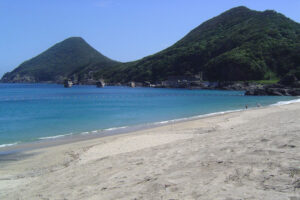 Isso is perhaps the safest swimming beach on the island. This lovely sandy beach is well equipped with changing rooms, toilets and shower facilities. From mid-July to August – the official beach open season – there is a lifeguard patrol and foodstalls. The best thing about Isso is that it is situated on one side of a small peninsula and on the other side of the peninsula (a 2 minute walk through the carpark) on the rocky shore is one of the best diving and snorkelling spots on the island.
Isso is perhaps the safest swimming beach on the island. This lovely sandy beach is well equipped with changing rooms, toilets and shower facilities. From mid-July to August – the official beach open season – there is a lifeguard patrol and foodstalls. The best thing about Isso is that it is situated on one side of a small peninsula and on the other side of the peninsula (a 2 minute walk through the carpark) on the rocky shore is one of the best diving and snorkelling spots on the island.
Miyanoura Beach
宮之浦海岸 - 宮之浦 (Miyanoura)
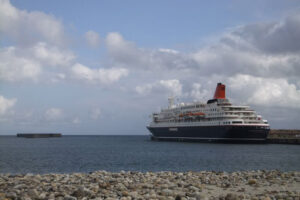 If you end up in Miyanoura with only a few hours left in the day and you wish to swim, then this small beach, although not ideal, is worth checking out. Heading south of Miyanoura then go over the Miyanoura River and take a left just after the Primary School. Follow this road and you’ll come to a small, sheltered sandy beach and a park with toilet facilities and a small shower. It’s not the best beach on the island, but it is certainly convenient if you are staying in Miyanoura.
If you end up in Miyanoura with only a few hours left in the day and you wish to swim, then this small beach, although not ideal, is worth checking out. Heading south of Miyanoura then go over the Miyanoura River and take a left just after the Primary School. Follow this road and you’ll come to a small, sheltered sandy beach and a park with toilet facilities and a small shower. It’s not the best beach on the island, but it is certainly convenient if you are staying in Miyanoura.
Tashiro Coast
田代海岸 - 安房 (Anbo)
 Situated halfway between the airport and Anbo this beach is famous for it’s interesting rock formations that were formed tens of thousands of years ago. The tourist sign says ‘Pillow-like’ rock formations, but don’t expect anything soft and fluffy. Follow the road down through the forest and park at the bottom.
Situated halfway between the airport and Anbo this beach is famous for it’s interesting rock formations that were formed tens of thousands of years ago. The tourist sign says ‘Pillow-like’ rock formations, but don’t expect anything soft and fluffy. Follow the road down through the forest and park at the bottom.
There are 2 signposted paths: one will take you to the Tashiro beach: a long sandy beach with views of Tanegashima. Surfers occasionally visit this side of the beach, but this is not a swimming spot. Paddling is fine and there are lots of interesting rocks to climb over and explore. The other path takes you to the ‘pillow-shaped lava field’ and a rocky beach. This is where you can swim, snorkel and play in the river. As it is very rocky you will need foot protection.
There are also warning signs not to let children swim alone as the current can be strong. There is parking, but no shower or toilet facilities. On foot it’s a 15 to 20 minute walk down to the beach from the main road.
Haruta-hama Beach
春田浜海水浴場 - 安房 (Anbo)
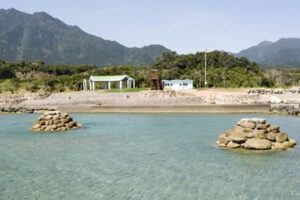 Haruta hama is situated a couple of kilometres south of Anbo Town. Heading south then take a left after crossing the bridge over the Anbo River. At Haruta Hama you can find a half natural, half man-made swimming pool that you share with some marine life, including a very sweet clown fish if you can find it. It’s sheltered and safe for kids to play in the water. There are also showers, toilets and a lifeguard over the summer holidays. Bring your goggles or a snorkel and you can see some beautiful marine life, particularly at low tide when you can explore the tidal pools on the rocky shore. Please bring footwear as the rocks around the tidal pools are very sharp and jagged.
Haruta hama is situated a couple of kilometres south of Anbo Town. Heading south then take a left after crossing the bridge over the Anbo River. At Haruta Hama you can find a half natural, half man-made swimming pool that you share with some marine life, including a very sweet clown fish if you can find it. It’s sheltered and safe for kids to play in the water. There are also showers, toilets and a lifeguard over the summer holidays. Bring your goggles or a snorkel and you can see some beautiful marine life, particularly at low tide when you can explore the tidal pools on the rocky shore. Please bring footwear as the rocks around the tidal pools are very sharp and jagged.
The landscape past the pool is also worth exploring as interesting rock formations spring up from a grassy heath that is punctured by tidal pools.
Kurio Beach
栗生海水浴場 - 栗生 (Kurio)
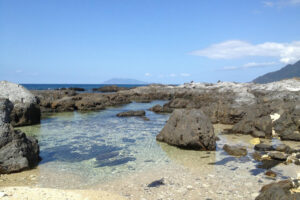 Kurio has two beaches that you can visit and swim. Kurio Hama is a lovely sandy, sheltered bathing spot situated in the village of Kurio. Look out for some interesting boat houses and turn left just after them. This beach is an important nesting point for sea turtles so some areas above the high-tide line are cordoned off to protect the nesting sites. There are toilets, a shelter and a re-charging station for electric cars in the car park.
Kurio has two beaches that you can visit and swim. Kurio Hama is a lovely sandy, sheltered bathing spot situated in the village of Kurio. Look out for some interesting boat houses and turn left just after them. This beach is an important nesting point for sea turtles so some areas above the high-tide line are cordoned off to protect the nesting sites. There are toilets, a shelter and a re-charging station for electric cars in the car park.
The second swimming area in Kurio is the Tzukazaki Tide Pool. This is just over the river on the way out of Kurio. Take a left when you see the campsite sign and follow the road down to the shore where there is parking. On the left side are the beautiful transparent waters of Kurio River. Walk down the path to the right and you’ll come to a small sandy and rocky beach which is one of the best diving and snorkelling spots on the island. Walk around the small headland between the river and the beach and you’ll find rocks to clamber over and interesting tidal pools to explore. There are basic shower facilities and a couple of shelters with bench seating.
However, beautiful though this area is for snorkelling, it also has a dangerously fast current and so extra caution is required at this location.
Nagata Inaka-hama Beach
永田いなか浜 - 永田 (Nagata)
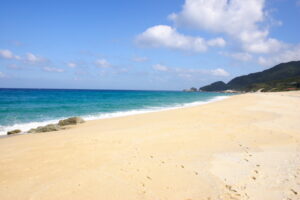 This long beach of golden granite sand in the north west of Yakushima is one of the island’s most beautiful beaches. Unfortunately, it is not a designated swimming beach due to its sudden depth and fast current. There are no lifeguards so you swim at your own risk.
This long beach of golden granite sand in the north west of Yakushima is one of the island’s most beautiful beaches. Unfortunately, it is not a designated swimming beach due to its sudden depth and fast current. There are no lifeguards so you swim at your own risk.
Inakahama and its neighbouring beach, Maehama, are not only popular with sightseers, they are also the largest nesting ground for loggerhead turtles in the Asia Pacific region and an important nesting ground for green turtles. The turtle nesting season spans from May to July. Baby turtles usually hatch between July and September and we request that visitors refrain from the temptation to visit the beaches early in the morning in the hope of spotting young turtles make their way to the sea. Your presence on the beach is distressing for the young turtles who already have a minuscule chance of survival even if they do make it to the sea.
Due to its special status as a vital habitat for endangered species, the beaches of Nagata are on the Ramsar list of protected wetlands. Volunteers keep the beach clean and protect the nesting sites. Please help them by staying away from the nesting areas and taking your litter home with you. Find out more about the sea turtles that visit Yakushima or book a YES Turtle Tour.
River Swimming Spots
Swimming in a river is the perfect solution to escape the humidity of the coast in the summer months: cool and refreshing even in the height of summer. There are plenty of places you will stumble across as you travel around the island. A note of warning: every year there are reports of accidents, and even tragedies, as the rivers can be very strong in places. The flow of a river can wash people downstream or a swimmer can get trapped between the rocks. Under-currents are also a real danger. If swimming with children then please take extra care and stay vigilant.
A request
To help preserve Yakushima’s pristine environment please treat the rivers with respect and take care not to pollute them in any way. The rivers are our source of drinking water.
Yoggo-Keikoku (Nagata River)
横河渓谷(永田川)
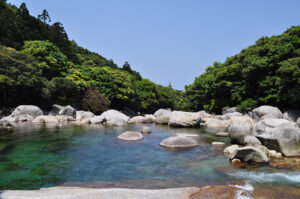 This is one of the best river swimming spots on the island. If you’re travelling to Nagata from the east, then cross the Nagata River and turn left. Follow the road that runs parallel to the river for a few kilometres until you come to a small car park and public toilet. From there take the path for a few hundred metres through the forest and you’ll come to a beautiful, large natural river pool. Even if it’s too cold to go swimming, this is a lovely spot for a picnic or to just gaze at the water and marvel at the huge boulders that surround you. From here you can go upstream for shower climbing, but please book a guide to do this as this activity can be hazardous without local knowledge. Also be aware that during or after heavy rainfall flash floods can occur. There are warning signs not to swim at these times.
This is one of the best river swimming spots on the island. If you’re travelling to Nagata from the east, then cross the Nagata River and turn left. Follow the road that runs parallel to the river for a few kilometres until you come to a small car park and public toilet. From there take the path for a few hundred metres through the forest and you’ll come to a beautiful, large natural river pool. Even if it’s too cold to go swimming, this is a lovely spot for a picnic or to just gaze at the water and marvel at the huge boulders that surround you. From here you can go upstream for shower climbing, but please book a guide to do this as this activity can be hazardous without local knowledge. Also be aware that during or after heavy rainfall flash floods can occur. There are warning signs not to swim at these times.
Kurio River
栗生川
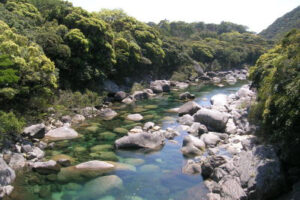 Located in the south of Yakushima you can access the beautiful aqua-marine river mouth from the parking area at the bottom of the road, after the Yakushima Youth Travel Village Campsite. There is a shower and a shelter, and the snorkelling and diving site of the Tzukazaki Tide Pools is only a minute’s walk away. The river meanders slowly to the sea through Kurio Town – one of the prettiest of the island’s villages. It is ideal for kayaking, swimming, snorkeling or just cooling off. The river mouth is also the only place on the island where the candle mangrove trees grow. If you follow the river upstream you will come to the Shakunage Park – a riverside walk which in spring bursts with colour when the variety of rhodedendrons bloom (shakunage in Japanese).
Located in the south of Yakushima you can access the beautiful aqua-marine river mouth from the parking area at the bottom of the road, after the Yakushima Youth Travel Village Campsite. There is a shower and a shelter, and the snorkelling and diving site of the Tzukazaki Tide Pools is only a minute’s walk away. The river meanders slowly to the sea through Kurio Town – one of the prettiest of the island’s villages. It is ideal for kayaking, swimming, snorkeling or just cooling off. The river mouth is also the only place on the island where the candle mangrove trees grow. If you follow the river upstream you will come to the Shakunage Park – a riverside walk which in spring bursts with colour when the variety of rhodedendrons bloom (shakunage in Japanese).
Tashiro River
田代川
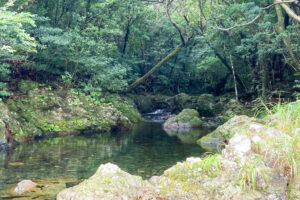 From the parking area at the end of the road to Tashiro Kaigan then take the path on the right and it will lead you to the pillow-shaped lava field where a small river runs to the sea. In summer this makes a perfect place for children of all ages to play. There are stretches of shallow, crystal clear water, with deeper pools to jump in a little upstream. If you explore further then there is a waterfall. Even in the midst of summer, swimming here offers a refreshingly cool and shady haven.
From the parking area at the end of the road to Tashiro Kaigan then take the path on the right and it will lead you to the pillow-shaped lava field where a small river runs to the sea. In summer this makes a perfect place for children of all ages to play. There are stretches of shallow, crystal clear water, with deeper pools to jump in a little upstream. If you explore further then there is a waterfall. Even in the midst of summer, swimming here offers a refreshingly cool and shady haven.
Anbo River
安房川
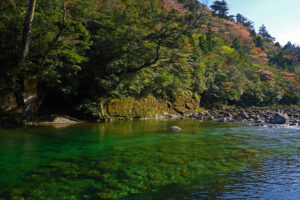 You’re most likely to get the chance to go swimming in the green waters of Anbo River if you book a kayak tour and head upstream as you can only access the river easily from lower down the river from the village of Anbo. Once you pass the town, the river meanders lazily through a beautiful deep green forested valley. There is a good swimming spot with a swing rope. You can kayak as far as the high red bridge called the Matsumine Bridge. Further past the bridge the river runs shallow and rocky, and is inaccessible in a kayak. If you’re in a kayak you’ll be able to park at the bridge and have a refreshing dip or explore the rocky reaches of the river on foot.
You’re most likely to get the chance to go swimming in the green waters of Anbo River if you book a kayak tour and head upstream as you can only access the river easily from lower down the river from the village of Anbo. Once you pass the town, the river meanders lazily through a beautiful deep green forested valley. There is a good swimming spot with a swing rope. You can kayak as far as the high red bridge called the Matsumine Bridge. Further past the bridge the river runs shallow and rocky, and is inaccessible in a kayak. If you’re in a kayak you’ll be able to park at the bridge and have a refreshing dip or explore the rocky reaches of the river on foot.


